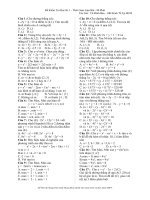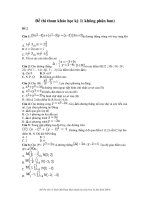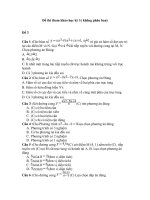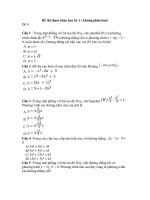Đề thi tham khảo ECONOMETRICS
Bạn đang xem bản rút gọn của tài liệu. Xem và tải ngay bản đầy đủ của tài liệu tại đây (120.44 KB, 10 trang )
ECONOMETRICS
Allowable materials:
1. Non programmable calculator
2. Unmarked, non-electronic Foreign Language dictionary
PART I: MULTIPLE-CHOICE QUESTIONS (30*2=60 marks). Answer space is
provided below
1
2
3
4
5
6
Multicollinearity may be present in your model if
A. some or all of your t-ratios are individually small (cannot reject individual slopes
being zero), but the F-test value is large (rejects all slopes simultaneously zero)
B. the t-ratios and the F-test value are both small
C. the maximized value of the log-likelihood is large
D. The R-squared value for the fitted model is large
One way of resolving heteroskedasticity is
A. by applying least squares with weights that are given by the White’s test for
detecting heteroskedasticity.
B. by applying the method of unweighted least squares.
C. by using the weighted transformation that Breusch and Godfrey proposed.
D. by applying weights on the residuals so that none of them spreads unequally
anymore.
If your dataset has serial correlation, but you completely ignore the problem and use a
plain OLS command, you will:
A. get biased parameter estimates.
B. you get OLS estimators that are no longer BLUE.
C. you get F-statistics that are no longer correct.
Heteroscedasticity in your data is a problem because:
A. ordinary OLS assumes that the data are homoscedastic and calculates the point
estimates of regression parameters accordingly
B. ordinary OLS assumes that the data are homoscedastic and calculates the
standard error estimates of the parameters accordingly
C. it biases the parameter point estimates
Look at the regression results, you find the Durbin-Watson stat is 2.000186. You
understand that
A. There is evidence of positive serial correlation because the DW statistic is very
close to 2.
B. There is evidence of negative serial correlation because the DW statistic is very
close to 2.
C. There is no evidence of serial correlation because the DW statistic is very close to
2.
Multicollinearity exists if there is a high correlation between your one (or more) of your
1
7
8
9
10
11
explanatory variables.
A. True
B. False
Dummy variables are categorical variables, with no natural numerical values. We
usually assign D=0 for the base or numeraire group, which is typically the majority
group, and D=1 for the alternative, or special group. But we could just as easily do it
the other way around, or we could assign D=-5 for the numeraire and D=12 for the
alternative group.
A. True
B. False
Auxiliary R-squared regressions consist of
A. Y regressed on each of the X-variables in turn
B. each of the X-variables regressed on each other X variable, one at a time
C. each of the X-variables regressed on all other X variables at once
D. each of the X-variables regressed on all possible subsets of X-variables.
One possible way to check for evidence of heteroskedasticity informally is:
A. by plotting the residuals of a multiple regression model against the dependent
variable and all the regressors.
B. by plotting the squared residuals of a multiple regression model against the
dependent variable and all the regressors.
C. by plotting the residuals of a multiple regression model against the dependent
variable only.
D. by plotting the squared residuals of a multiple regression model against all the
regressors.
Multicollinearity exists if there is a high correlation between your dependent variable
and any one (or more) of your explanatory variables.
A. True
B. False
How do you test whether there is significant quarterly seasonality in a time- series of
quarterly data?
A. Estimate a model with three quarterly dummy variables and conduct a joint F- test
of whether the coefficients on the three dummy variables are simultaneously equal
to zero.
B. Put in dummy variables for each quarter one at a time in a set of four regressions.
C. Estimate a model with four quarterly dummy variables and no intercept.
12 Perfect multicollinearity is highly dangerous because the estimated betas
you will
get from OLS will be biased and inefficient.
A. True
B. False
13 If you wish to use a set of dummy variables to capture six different categories of an
explanatory variable, you should use six different dummy variables, each equal to one
when the observation is a member of a specific category and equal to zero otherwise.
A. True
B. False
14 Multicollinearity
A. compromises the goodness-of-fit of your regression model
B. can make it difficult to distinguish the individual effects on the dependent variable
of one regressor from that of another regressor.
2
C. causes the values of estimated coefficients to be insensitive to the presence or
absence of other variables in the model
D. causes t-ratios to be high and F-tests to be low
15 Look at the regression results, you find the Durbin-Watson stat is 0.370186. You
understand that
A. There is evidence of positive serial correlation because the DW statistic is very
small.
B. There is evidence of negative serial correlation because the DW statistic is very
small.
16 Which of the following equation is AR(2)
A. ut = ρ 1.ut-1 + vt.
B. ut = ρ 1.ut-1 + ρ 1.ut-2 + vt.
C. ut = ρ 1.ut + ρ 2.ut-2 + vt.
17 The best way to detect multicollinearity in a multiple regression model is to
A. look at plots of each regressor against all other regressors
B. to find any high pairwise correlations
C. look for low t-ratios
D. look for high R-squared values
E. conduct auxiliary regressions and look for high R-squareds
18 By heteroskedasticity we mean
A. that the residuals of a regression model are not independent.
B. that the residuals of a regression model are related with one or more of the
regressors.
C. that the squared residuals of a regression model are not equally spread.
D. that the variance of the residuals of a regression model is not constant for all
observations.
19 In your data set, your explanatory income variable, INC, is coded as 1= income
between 0 and 10,000 per year, 2=income between 10,000 and 25,000 per year, 3=
income between 25,000 and 50,000 per year, 4= income between 50,000 and 75,000
per year, and 5= income greater than 75,000 per year. The best way to handle these
data is to:
A. recognize that INC is not perfect, but use it as an explanatory variable anyway.
B. use the midpoints of each income interval, divided by 10,000 (to keep the
parameter point estimates from being too tiny).
C. create a set of 4 dummy variables, where each takes on the value of one for one
category and zero for all others; use this full SET of dummy variables as your
income variable.
D. use both INC and INC-squared as your explanatory variables, not just INC alone.
20 For the regression equation Y = 10 - 3X 1 + 2.5X2, which of the following statements is
true?
A. When X1 decreases by 3 units, Y decreases by 1 unit.
B. When X2 decreases by 2.5 units, Y decreases by 1 unit.
C. When X1 decreases by 1 units, Y increases by 3 unit.
21 In comparing linear models with log-log models, we take logarithms of all nonnegative continuous variables, but we do not use the logs of dummy variables. This is
because:
A. log of 1 is zero and log of 0 is undefined.
B. Adam Smith decreed that economists should never log a dummy variable.
3
C. only dummies attempt to log dummy variables.
22 In the estimated regression equation Y = 2.5 - 2 X, which of the following is NOT a
correct interpretation of the slope coefficient?
A. The dependent variable increases by 2 units if X decreases by 1 unit.
B. The dependent variable declines by -2 units if X increases by 1 unit.
C. If the value of X is zero, the value of Y will be -2.
23 Heteroscedasticity happens when which of the following OLS assumption is not
fulfilled?
(
)
A. E u i X i = 0
(
)
2
2
B. E u i X i = σ
(
)
C. Cov u i , u j = 0 with i ≠ j
24 Which of the following is NOT an assumption of linear regression analysis?
A. The Y values are statistically independent.
B. The normal distributions are within 3 standard deviations from the line regression.
C. Y values are normally distributed.
D. The means of the distribution of Y values all lie on the straight line of regression.
25 By autocorrelation we mean
A. that the residuals of a regression model are not independent.
B. that the residuals of a regression model are related with one or more of the
regressors.
C. that the variance of the residuals of a regression model is not constant for all
observations.
26 In a two-variable model Yi = β1 + β 2 X 2i + u i , β 1 and β 2 are known as:
A. partial regression coefficients
B. slope coefficient and intercept respectively
C. intercept and slope coefficient respectively
D. intercept and partial regression coefficient respectively
27 Which sentence given below is Incorrect?
A. The disturbance term is a random variable that has well-defined probabilistic
properties.
B. The disturbance term can take negative value only.
C. The disturbance term is an unobservable random variable.
D. The disturbance term can take positive or negative values.
28 In the case of existing less than perfect multicollinearity problem, OLS estimators’
variances will appear to be……………………than normally.
A. smaller
B. larger
29 Given a two-variable model Yi = β1 + β 2 X 2i + u i , the estimator β 2 in the presence of
autocorrelation is:
A. a BLUE
B. a linear unbiased but not the best estimator
C. a best linear but biased estimator
D. a best unbiased but non-linear estimator
30 Which indicator shows how well a regression line fits through the scatter of data
points?
4
A. F-test
B. R2
C. t-test
Answer Space
1
2
3
4
5
6
7
8
9
10
11
12
13
14
15
16
17
18
19
20
21
22
23
24
25
26
27
28
29
30
5
PART II: PROBLEM
(40 marks: 8 questions*4pts=36, except for question 2: 6
points and for question 6: 2 points)
Consider the following demand function for money in the United States for the period
1980:1 – 2003:4:
β 2 β 3 ut
(1)
t
1 t
t
where M = real money demand (in billions USD), using the M2 definition of money (in
billions USD),
Y = real GDP (in billions USD), and R= interest rate (in %)
M =βY R e
1. Preliminary Question
1.1. Your data gives you the nominal quantities; can you describe how to convert
nominal quantities into real quantities?
1.2. Equation (1) is a linear regression model or non-linear model? Why? If this is nonlinear, do the transformation so that we can estimate it using OLS method.
1.1. To convert nominal quantities into real quantities, one needs to divide the nominal
money M and nominal GDP by CPI (Consumer Price Index) or Deflator. There is no need to
divide the interest rate variable by CPI or Deflator.
1.2. Equation (1) is not a linear regression model as all the parameter betas are in power
form. We need to transform the non-linear regression function at the beginning into a
linear regression form by taking the ln(natural log) the equation:
(2).
Equation (2) is our regression function.
Here is the regression result:
Dependent Variable: LOG(M)
Method: Least Squares
Date: 12/10/08 Time: 18:57
Sample(adjusted): 1980:1 2003:3
Included observations: 95 after adjusting endpoints
Variable
Coefficient
Std. Error
t-Statistic
C
1.407849
0.217476 (1)6.473596
LOG(Y)
0.549451 (2)0.046806
11.73902
LOG(R)
-0.073395
0.014350 (3)-5.114764
R-squared
0.873860 Mean dependent var
Adjusted R-squared
(5)0.871118 S.D. dependent var
S.E. of regression
(6)0.050179 Akaike info criterion
Sum squared resid
0.231653 Schwarz criterion
Log likelihood
150.9795 F-statistic
Durbin-Watson stat
0.044972 Prob(F-statistic)
Prob.
0.0000
0.0000
0.0000
3.607830
0.139775
-3.115358
-3.034709
(4)318.6748
0.000000
6
2. Write the estimated regression function and briefly interpret the
coefficients
LOG(M)^= 1.407849+0.549451 LOG(Y) -0.073395 LOG(R)
Beta2=0.549451, meanings that if the real GDP (Y) increases by 1% on average in
this sample, the real demand for money (in term of M2) increase of 0.55%, given
other variables remains constant.
(Remember in the log-log functional form, the value of the coefficient beta is
exactly the value of elasticity)
Beta3=-0.073395, meanings that if the interest rate increases by 1% then the real
demand for money will decrease of 0.073%, given other variables remains
constant.
Beta1=1.407849, meanings that if the real GDP (Y) equal to one and interest rate
equal to one (or log equals to zero), then the demand for money is
exp(1.407849)=3increases by 1% on average in this sample, the real demand for
money (in term of M2) increase of 0.55%. (remember in the log-log functional
form, the value of the coefficient beta is exactly the value of elasticity)
3. Calculate the missing values in the regression results and explain its
significations
Value (1) t-stat1=beta1/std(beta1)= 1.407849/0.217476=6.473596, measures the
individual significant of the beta1
Value (2) standard error2= beta2/ t-stat2=0.549451/11.73902=0.046806 measures the
standard deviation of the beta2
Value (3) t-stat3=beta3/std(beta3)= -0.073395 /0.014350=-5.1147
Value (4) F stat =R2 *(n-k)/(1- R2)(k-1)= 0.873860*(95-3)/(1-0.873860)*(3-1)=318.6748
Value
(5)
R2
adjusted
=1-(1/
R2)*(n-1)/(n-k)=1-(1-0.873860)*(95-1)/(95-3)=
0.871118
measures the effectiveness influence of independent variables,
Value (6)
S.E. of regression= (Sum squared resid/(n-k))^0.5=(0.231653/(95-3))^0.5=0.050179
It measures the standard deviation of the residual
Kim Anh a: this part, you can look at the book for more details.
4. Which of the coefficients are individually statistically significant and
not significant at 5% level? Do the t-test, given the t-critical t c is equal
to 2. Construct the interval of confidence for the coefficients with the
given t-critical.
H0: betai =0, the coefficient betai is individually not significant
H1: betai#0, the coefficient betai is individually significant
/t-statistic/=(betai^- betai)/std betai compare with the t-critical=2
If the /t-statistic/ is higher than t-critical, we reject H0, then…
7
In this model, all the three are statistically significant as …
For the interval construction, the formula is provided, so no problem….
5. Can you establish a test of the overall significance of the regression?
It is just the conventional F-test : statement of H0, H1, calculate F-statistic as in
the previous question, F critical.
Students do not need the F critical to conclude the overall significant.
First reason: the F-statistic is very high 318.6748
Second reason: all the t-statistics are statistically significant
Third reason: look at the R2 and R2 adjusted, they are high.
Four reason: they may know that the F critical is only 3.1
6. Do you suspect that there is Multicollinearity in this regression?
I do not suspect any Multicollinearity problem in this regression as all the tstatistics are significant and the R2 are not very very high.
7. Based on D-W d-test, what can you conclude about the model’s
autocorrelation at 5%? Given the dL and dU respectively are 1.489
and1.573, explain how to find these critical values for this particular
model (assume that we have D.W d table)
Before the test, observe the d=0.044972 lower than 2, so we suspect the positive
autocorrelation
H0 : ρ = 0
H1 : ρ > 0
no autocorrelation
yes, positive autocorrelation
D.W-d table to find the critical value k’=2 and n=95: dL =1.489 and dU
=1.573
d=0.044972 < dL =1.489: reject Ho, there exists a positive autocorrelation
in this model
8
8. Here is part of the test for higher-order autocorrelation, what can we
conclude, given the critical value is 9.48775. Explain how to find the
critical value
Breusch-Godfrey Serial Correlation LM Test:
F-statistic
469.5326 Probability
Obs*R-squared
90.74799 Probability
Test Equation:
Dependent Variable: RESID
Variable
Coefficient
Std. Error
t-Statistic
C
-0.082657
0.051620
-1.601266
LOG(Y)
0.017122
0.011068
1.546997
LOG(R)
0.006113
0.003412
1.791842
RESID(-1)
1.034548
0.107355
9.636736
RESID(-2)
0.020620
0.154456
0.133501
RESID(-3)
-0.039154
0.155146
-0.252368
RESID(-4)
-0.042845
0.107836
-0.397316
R-squared
0.955242 Mean dependent var
Adjusted R-squared
0.952190 S.D. dependent var
0.000000
0.000000
Prob.
0.1129
0.1255
0.0766
0.0000
0.8941
0.8013
0.6921
5.64E-16
0.049643
Critical value, Chi-square, alpha =5%, p=4, number of lag, order of lag order to
find 9.48775
Ho: No autocorrelation, there is a no higher-order autocorrelation
H1: Autocorrelation, there is a higher-order autocorrelation than p
The Chi-square statistic= Obs*R-squared=95*0.955242=90.74799 higher then critical
value 9.48775 at p=4, so we reject H0, there is a higher order autocorrelation than
4.
9. The White Heteroscedasticity test is also provided. Explain how to
compute the chi-squared value based on provided information and tell
us the conclusion of the test?
White Heteroskedasticity Test:
F-statistic
12.84273
Obs*R-squared
34.52080
Test Equation:
Dependent Variable: RESID^2
Included observations: 95
Variable
Coefficient
C
-0.774543
LOG(Y)
0.367448
(LOG(Y))^2
-0.043342
LOG(R)
-0.001272
Probability
Probability
Std. Error
0.133687
0.063099
0.007417
0.001284
0.000000
0.000001
t-Statistic
-5.793708
5.823390
-5.843390
-0.991102
Prob.
0.0000
0.0000
0.0000
0.3243
9
(LOG(R))^2
R-squared
Adjusted R-squared
0.000515
0.363377
0.335082
0.000480
1.072134
Mean dependent var
S.D. dependent var
0.2865
0.002438
0.001899
Critical value, Chi-square, alpha =5%, number of variables k’=4, so critical value
is the same as the previous one, so Chi-square critical is 9.48775
Ho: homoscedasticity
Var ( ui ) = σ2
H1: heteroscedasticity
Var ( ui ) = σi2
The Chi-square statistic= Obs*R-squared=95*0.363377=34.52080 higher then critical
value 9.48775 at k’=4, so we reject H0, there is a heteroscedasticity problem in
this model, or we can say that the variance of errors terms are not constant.
10. What is your final conclusion of the model? (Synthetic)
- This model explains the real demand of money as a positive function of real GDP
(Y) and the interest rate as follows the Keynesian model. The empirical data of the
GDP and interest rate of US explains for 87.36% of the variations of the demand for
money M2.
- The model has all coefficients statistically significant, and no problem of multicollinearity (for
informal test) implying that there is no correlation between the real GDP and the interest rate.
- This model however has the problem of autocorrelation as well as the problem of
heteroskedasticity, imply that the coefficient estimators may not be the BLUE (still
unbiased but not having the minimum variance).
- We need to correct the problem of heteroskedasticity, as it may influence the tstatistic of the coefficients of GDP and interest rate…
Bref: open question for econometrics conclusion or on economical problem.
Formulae and Free Space
10









